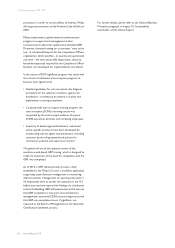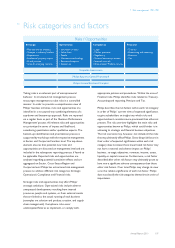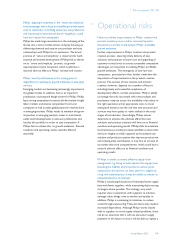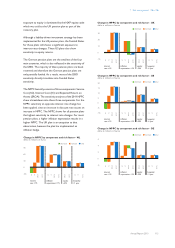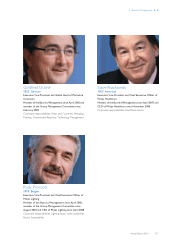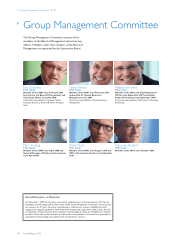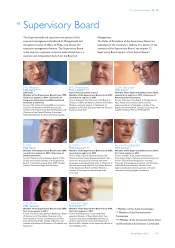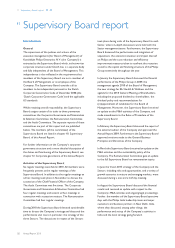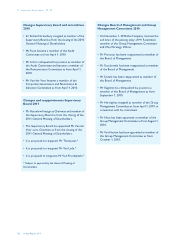Philips 2010 Annual Report Download - page 113
Download and view the complete annual report
Please find page 113 of the 2010 Philips annual report below. You can navigate through the pages in the report by either clicking on the pages listed below, or by using the keyword search tool below to find specific information within the annual report.7 Risk management 7.6 - 7.6
Annual Report 2010 113
Corporate Control, together with Sector and Functional
management, performs an assessment of financial
reporting risks at least annually.
For each risk identified a risk rating is assigned based on
the likelihood of occurrence and the potential impact of
the risk on the financial statements and related
disclosures. In determining the probability that a risk will
result in a misstatement of a more than inconsequential
amount or material nature, the following factors are
considered to be critical: complexity of the associated
accounting activity or transaction process, history of
accounting and reporting errors, likelihood of significant
(contingent) liabilities arising from activities, exposure to
losses, existence of related party transaction, volume of
activity and homogeneity of the individual transactions
processed and changes to the prior period in accounting
characteristics.
Important critical reporting risk areas identified within
Philips following the risk assessment are:
•complex accounting for sales-related accruals, warranty
provisions, tax assets and liabilities, pension benefits,
and business combinations
• complex sales transactions regarding multi-element
deliveries (combination of goods and services)
• valuation procedures with respect to assets (including
goodwill and inventories)
• past experience of control failures regarding
segregation of duties
• significant (contingent) liabilities such as environmental
claims and other litigation
• outsourcing of high volume/homogeneous
transactional finance and IT operations to third-party
service providers.
Processes and controls related to the identified critical
risk areas will be subject to a more detailed set of
requirements regarding control documentation and
control evaluation (monitoring) by Sector and Functional
management due to their importance for the reliability of
the financial statements and disclosures of the Group.
Philips is exposed to a number of different fiscal
uncertainties which could have a significant impact on
local tax results.
Philips is exposed to a number of different tax
uncertainties which could result in double taxation,
penalties and interest payments. These include, amongst
others, transfer pricing uncertainties on internal cross-
border deliveries of goods and services, tax uncertainties
related to acquisitions and divestments, tax uncertainties
related to the use of tax credits and permanent
establishments, tax uncertainties due to losses carried
forward and tax credits carried forward and potential
changes in tax law that could result in higher tax expense
and payments. Those uncertainties may have a significant
impact on local tax results which in turn could adversely
affect Philips’ financial condition and operating results.
The value of the losses carried forward is not only subject
to having sufficient taxable income available within the
loss-carried-forward period, but also subject to having
sufficient taxable income within the foreseeable future in
the case of losses carried forward with an indefinite carry-
forward period. The ultimate realization of the
Company’s deferred tax assets, including tax losses and
credits carried forward, is dependent upon the generation
of future taxable income in the countries where the
temporary differences, unused tax losses and unused tax
credits were incurred and during the periods in which the
deferred tax assets become deductible. Additionally, in
certain instances, realization of such deferred tax assets is
dependent upon the successful execution of tax planning
strategies. Accordingly, there can be no absolute
assurance that all (net) tax losses and credits carried
forward will be realized.
For further details, please refer to the fiscal risks
paragraph in note 3.
Philips has defined-benefit pension plans in a number of
countries. The funded status and the cost of maintaining
these plans are influenced by financial market and
demographic developments, creating volatility in Philips’
financials.
The majority of employees in Europe and North America
are covered by defined-benefit pension plans. The
accounting for defined-benefit pension plans requires
management to determine discount rates, expected rates
of compensation and expected returns on plan assets.
Changes in these variables can have a significant impact on
the projected benefit obligations and net periodic pension
costs. A negative performance of the financial markets
could have a material impact on funding requirements and
net periodic pension costs and also affect the value of
certain financial assets and liabilities of the company.
Details of pension risks
With pension obligations in more than thirty countries,
Philips has devoted considerable attention and resources
to ensure disclosure, awareness and control of the
resulting exposures.
Dependent on the investment policy of the respective
pension plans, developments in financial markets may have
significant effects on pension liabilities (DBO), pension
assets (MVA), resulting Funded Status and net periodic





